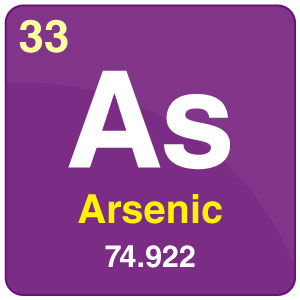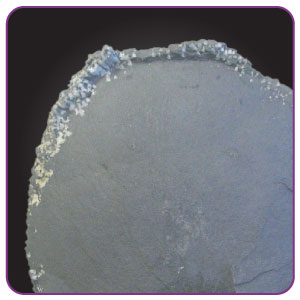
| Symbol | As |
| Atomic Number | 33 |
| Atomic Mass | 74.922 |
| Discovered by | Arsenic was discovered by Albertus Magnus |

Table of Contents
What is Arsenic?
Arsenic, a chemical element placed in the nitrogen group of the periodic table that exists in both the gray and yellow crystalline forms.
Arsenic is present in three allotropic forms- black, yellow and gray. A silver-gray and brittle crystalline solid are the stable forms. It gets tarnished rapidly when comes in contact with air and at high temperatures by preparing a white cloud of arsenic trioxide. The metallic form of the element is brittle and it gets tarnished when oxidized to arsenic trioxide. Its non-metallic form is less reactive but easily dissolves when heated with strong oxidizing acids and alkalis.
Arsenic is a steel-gray, brittle solid with low thermal and electrical conductivity. There are some forms of elemental arsenic are metal-like and is best classified as a non-metal. Some other forms are also there but are not properly characterized. This element sublimes at 613 °C and it exists as As4 molecules. It is stable in dry air and in moist air it tends to become coated with a black oxide. The sublimed arsenic vapor heated in air to form an arsenic oxide.
Chemical Properties Of Arsenic
| Group | 15 | Melting point | Sublimes at 616°C, 1141°F, 889 K |
| Period | 4 | Boiling point | Sublimes at 616°C, 1141°F, 889 K |
| Block | p | Density (g cm−3) | 5.75 |
| Atomic number | 33 | Relative atomic mass | 74.922 |
| State at 20°C | Solid | Key isotopes | 75As |
| Electron configuration | [Ar] 3d104s24p3 | CAS number | 7440-38-2 |
| ChemSpider ID | 4514330 | ChemSpider is a free chemical structure database | |
Uses Of Arsenic
- This element is mainly used in compounds and a smaller amount is used in alloys.
- It is also used to prepare lead shot in past and the amount used in these applications continues to decrease.
- Arsenic can easily get into the environment from such applications. Some amount is added to silicon and germanium to make transistors.
- Gallium arsenide, a compound of arsenic is used to make light-emitting diodes (LEDs). These LEDs produce the lighted numbers in the clock, watches, hand-held calculators and different other electronic devices.
Recommended Videos
Oxoacids of Halogens | p-Block Elements

Frequently Asked Questions – FAQs
What is arsenic used for?
Arsenic is employed as a doping agent in semiconductors for solid-state devices (gallium arsenide). Bronzing, pyrotechnics, and hardening shot are among uses for it. Arsenic compounds can be used to manufacture specialty glass and keep wood in good condition.
Is arsenic a poison?
In its inorganic form, arsenic is extremely hazardous. The greatest concern to human health from arsenic is contaminated water used for drinking, food preparation, and irrigation of food crops. Arsenic poisoning from drinking water and eating can lead to cancer and skin sores over time.
Does boiling water kill arsenic?
Arsenic cannot be removed from water by heating or boiling it. Because some water evaporates during the boiling process, the arsenic concentrations in the water can actually rise significantly. Furthermore, treatment with chlorine (bleach) will not remove arsenic.
Is arsenic used in medicine?
Arsenic (As) is a poison that is often used. Only a few people are aware that As is commonly used in medicine. As and its compounds have been utilised in the treatment of ailments such as diabetes, psoriasis, syphilis, skin ulcers, and joint problems in the past.
What fruit contains arsenic?
Because arsenic is contained in the fruit, apple, pear, and grape juice may contain trace levels. If you blend juice from concentrate with arsenic-containing water, the arsenic content may be increased.


It’s very good learning app